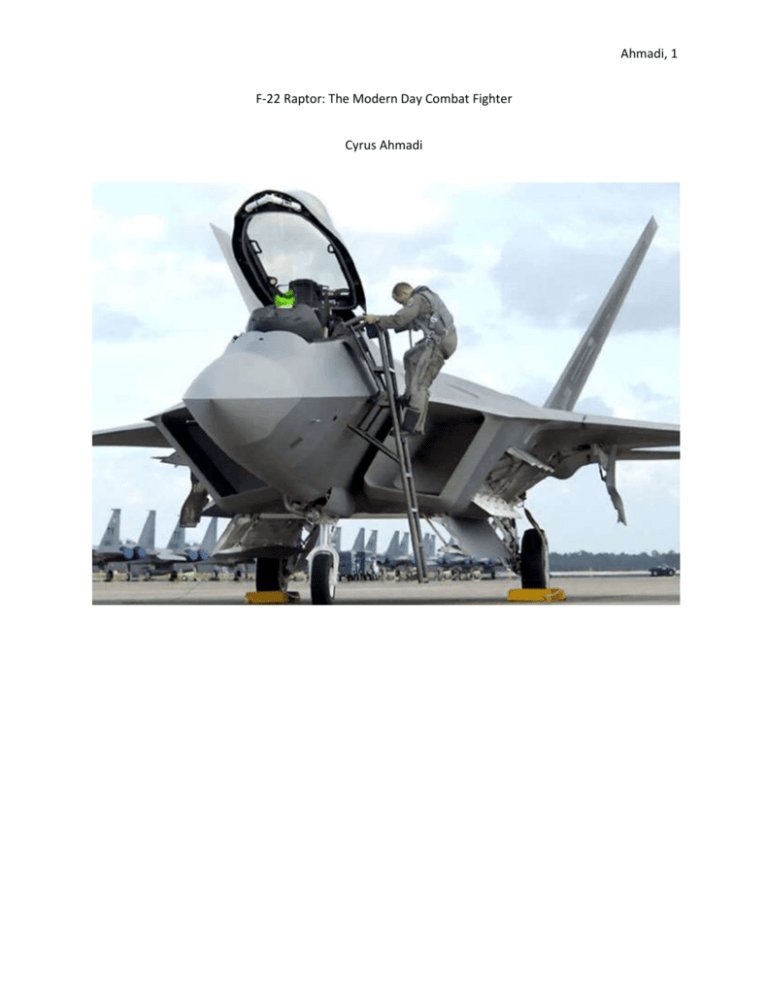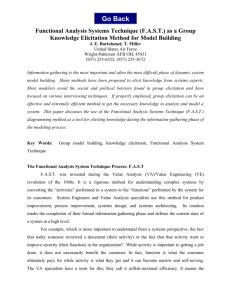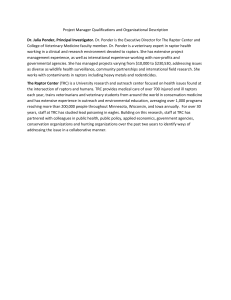ResearchP 425KB Dec 22 2009 10:51:36 PM
advertisement

Ahmadi, 1 F-22 Raptor: The Modern Day Combat Fighter Cyrus Ahmadi Ahmadi, 2 Introduction: Air combat is an absolutely critical component of modern day warfare. As a nation, the United States has a very well equipped and highly prepared military. Ever since World War 1, the utilization of aircraft for combat purposes has been a very important tool. This trend continued to grow and grow as time progressed, as the early days of utilizing aircraft solely for reconnaissance purposes vanished and they turned themselves into fully armed combat systems. The US Army is on the forefront of these combat systems with its highly advanced F-22 Raptor. The F-22 Raptor was designed from the ground up to be an aerial fighting machine, and has proved itself well in becoming a staple in the the current generation of jet fighters. Everything about the aircraft was planned and executed to surpass any previous contenders before it and herald a new era of warfare. It is a fantastically interesting piece of human achievement, both historically and when used in modern conflicts. As stated, the F-22 Raptor was designed to be a combat aircraft, built to replace the aging F-15 that had previously been the US jet fighter of choice. The main points that the F-22 set out to achieve were: stealth, supersonic cruise speed without the use of afterburners (supercruise), and integrated avionics. Other features that were focused on included increased range, maneuverability, reliability, and supportability over all previous aircraft. (Aronstein, Hirschberg, Piccirillo 1) These main concepts may seem fairly broad, but they are all very important in aerial combat situations. As a machine, an F-22 was engineered to be the next generation of combat fighter, having no competition. An F-22 is labeled as an “Advanced Tactical Fighter”, or ATF. This term was first coined in the 1970’s. (Aronstein, Hirschberg, Piccirillo, 5) Obviously the development of such an advanced piece of equipment is a heavy financial undertaking, and the ATF program was no exception. For an example of how expensive such things can be consider this statement, “The Dem/Val phase of the ATF program began with the aware of the prime contracts to Lockheed and Northrop on Oct. 31’st, 1986, valued at $691 millon each” (Aronstein, Ahmadi, 3 Hirschberg, Piccirillo, 103). These sorts of number are common to military budgets, when it comes to defense of the United States, no expense is spared. Obviously the reason for these large numbers was again, to have absolutely the best next generation jet fighter developed, the US Army wanted to be secure in air dominance. Time was also a very important factor and was just as exponential as the financial numbers put forth. In wind tunnel testing alone, the Lockheed ATF team contributed 17,930 hours of work. (Aronstein, Hirschberg, Piccirillo, 121) A constant desire to continue improving and furthering the technology of jet fighters made these sort of numbers possible. Everyone involved in the development of the F-22 raptor was eagerly willing to put forth 110% of their time and effort. This mindset allowed the development of an aircraft that would surpass any previous endeavors and enable the F-22 Raptor to become a reality. History: The history associated with such a marvelous piece of machine is well documented and captured in detail in books and articles worldwide. It all started in the 1980’s, when the ATF program first got developed and put into action, “The Advanced Tactical Fighter Statement of Operational Need (November 1984) detailed this need, and Congressional funding and approval were received in 1985.” (F-22 Raptor History) With the advent of this need, the US government was highly motivated and willing to replace the then aging F-15. Globalsecurity.org states the purpose of the F-22 was to, “Be the successor to the F-15, a long range air superiority fighter with the performance to kill any other tactical aircraft and the operating radius to threaten targets deep inside the USSR while flying from bases in Western Europe.” The F-22 was made to be a widely varied beast of many functions, with long range but very high maneuverability enabling the concept to be a very functional piece of work. Over the course of the 1990’s, funding was secured and the aircraft was becoming less of a concept and more of a reality. Billion dollar contracts were required for this reality to happen, and funding was of paramount Ahmadi, 4 importance throughout the project. The prototype YF-22 was the first step, being tested in August of 1991. (F-22 Raptor History) After this prototype was tested, some funding issues emerged to halt the aircrafts development but in 1992 these issues were resolved through panel meetings by those involved in the project. Shortly after this, the real components for a non-prototype F-22 were being put into production. Globalsecurity.org also states the new type of display methods that allowed the pilot to be more aware and capable than ever before presented the most technical problems, requiring the most ground testing and development of new software and hardware technologies to allow them to be ready for use in real life scenarios.(F-22 Raptor History) “Fabrication of the first part for the first flyable F-22 began on 08 December 1993, at Boeing's facilities in Kent, Wash” (F-22 Raptor History) and this continued on with various parts including the engines until 1997 finally arrived. On the seventh of September, 1997, the F-22 made its first successful flight, after much testing and development. This was however, only the first step in a very large sequence. Various tests were performed to meet the specifications that were outlined earlier, new software was developed and implemented. This trend would continue until the aircraft was ready for actual operational status. In March of 2001, the first operational F-22 was being assembled.(F-22 Raptor History) Finally, in December of 2005 the F-22 program received Initial Operational Capacity or IOC for short. “The road to IOC included the F-22A System Program Office turning Air Force requirements into a successful acquisition program; developmental flight test and evaluation, simulation and ground testing at various bases. The first combat-ready Raptors were assigned to the 27th Fighter Squadron, one of three squadrons assigned to the 1st Fighter Wing.” (F-22 Raptor History). This marked the final milestone of the initial program, but the F-22 Raptor will continue to have improvements through future technologies and developments. Ahmadi, 5 Technical Details: But what would all of this historic reference be without some real life technical data? Firstly, the weight of one of these jets is quite large at 43,340 lbs(Specifications|Lockheed Martin), giving a mass on Earth of 1345.96 slugs. With the relatively large mass, it’s surprising the F-22 can cruise at Mach 1.5 at 50,000 ft which is approximately 1452 ft/s in the air. Additional speeds may be found using the included table 1A. This is well beyond the speed of sound for that altitude, which is 968.1 ft/s. With this high cruising speed it can perform amazing maneuvers and aerial acrobatics higher than anything before it. The F-22 boasts a wing area of 840 square feet(Specifications|Lockheed Martin), with a highly efficient swept wing design. Due to this wing area and the velocity, we can then calculate the wing loading which is 51.60 lb/ft². The lift force of the plane is equal to the weight in steady level, non accelerated flight, at 43,340lbs, whereas with a full load the plane weighs 83,500lbs(Specifications|Lockheed Martin). In newtons this force would be 192,863N. Thrust put out from an F-22 is 35,000lbs, or 155,750N, thus drag would be equal to this amount. A single F-22 is 62 ft long with a 44.5ft wingspan! (Specifications|Lockheed Martin) Conclusion: To conclude, the F-22 was a major success on the part of the US army and it’s development was a spectacular achievement of US military power. All of the initial specifications including supercruise and stealth technology were implemented with great success into the craft and it is an unprecedented master of the skies. Since the early development of the ATF program in the 1980’s all the way up to the testing of engines and eventual testing of an F-22 itself, each milestone marked a new era for aerial warfare. With this achievement newer and more complicated operations will be more capable than ever before, opening up higher altitude, higher risk missions. As an overall goal to replace the F-15, the F-22 passed with flying colors and even exceeded certain requirements. From a simple vision on paper to a Ahmadi, 6 fully enabled multi tasking jet fighter, the F-22 raptor will carry the US army into the next generation of war. Ahmadi, 7 Technical Details and Equations for technical details: Tech Details: Weight: 43,340 lbs (full load: 83,500lbs) Mass on Earth: 1345.96 slugs Wing Loading: 840ft² Cruise speed: 1452 ft/s Lift force: 43,340lbs (192,863N) Thrust force: 35,000lbs (155,750N) Length of plane: 62ft Wingspan: 44.5ft Equations: Mass of an F-22: 𝑀= 𝑊 43,340𝑙𝑏𝑠 𝑀= 𝐺 32.2𝑓𝑡/𝑠 M = 1345.96 slugs Cruise Speed of an F-22 (at Mach 1.5): Ahmadi, 8 𝑀= 𝑉 𝑉 = 𝑀(𝑉𝑠) 𝑉𝑠 𝑉 = 1.5(968.1𝑓𝑡 𝑝𝑒𝑟 𝑠𝑒𝑐𝑜𝑛𝑑) V = 1452 ft/s Wing Loading of an F-22: 𝑊 43,340𝑙𝑏𝑠 = 𝑆 840𝑓𝑡 2 W/S = 51.60 lb/ft² Drag of an F-22: Thrust = Drag T = 35,000lbs in newtons: 35,000𝑙𝑏𝑠 ∗ 4.45𝑁 𝑙𝑏 T = 155,750N Ahmadi, 9 Works Cited and Reference Diagrams: Table 1A: F-22 Sketch: Ahmadi, 10 Works Cited David C. Aronstein, Micheal J. Hirschberg, Albert C.Piccirillo. Advanced Tactical Fighter to F-22 Raptor. Reston, VA: American Institute of Aeronautics and Astronautics Inc., 1998. F-22 Raptor History. 21 January 2008. 1 November 2009 <http://www.globalsecurity.org/military/systems/aircraft/f-22-history.htm>. F-22 Raptor Specifications. 21 January 2008. 1 November 2009 <http://www.globalsecurity.org/military/systems/aircraft/f-22-specs.htm>. Jr., John D. Anderson. The Airplane: A History Of It's Technology. Reston, VA: American Institute of Aeronautics and Astronautics, 2002. Specifications | Lockheed Martin. 1 November 2009 <http://www.lockheedmartin.com/products/f22/f22-specifications.html>.







